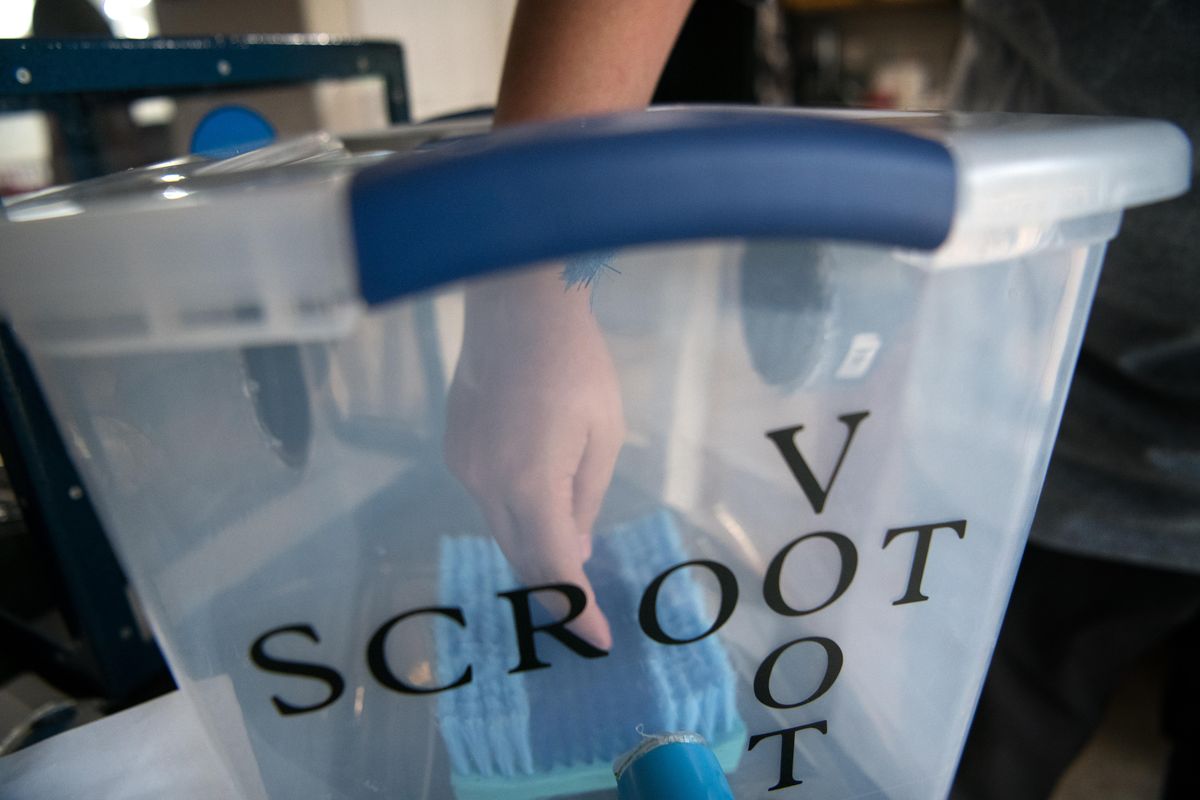Spokane-area kids are top contenders in innovation competition with astronaut device

The Rambunctious Astrobots is a team of kids that thinks inside the box – more specifically, inside the box of the Scroot Voot 2000, a device competing for a top global prize.
The team will travel with the Scroot Voot 2000 – which is slightly larger than a shoebox – next week to San Jose, California, to participate in the Global Innovation Award Competition.
The kids, ranging in age from 10 to 15, comprise an independent, nonschool-affiliated FIRST LEGO League robotics group that meets in Spokane Valley.
Cyndi Steele, of Spokane Valley, a mechanical engineer, has been coaching FIRST LEGO League teams for 10 years. This is the furthest one of her teams has gotten in competition.
Worldwide, there are 40,000 FIRST LEGO League teams. Every year, each team programs a robot to enter into a regional competition. If a team’s robot wins the regional contest, the team can apply to participate in the FIRST LEGO League’s Global Innovation Award Competition.
The robots and other entries are not made of Legos but Lego’s company, The Lego Group, sponsors the league. This year’s theme for the innovation award is “Into Orbit,” solutions to problems humans face in space over an extended period of time.
The global innovation contest is broader in scope than just robots. All entries must address real-world problems. Only 20 teams are selected worldwide to compete for the competition’s $20,000 prize.
The Scroot Voot 2000 is the team’s invention to address the real-world problem that was described by an astronaut, Scott Kelly, in a copy of National Geographic.
.
Isabelle Pefley, a 12- year old team member from Spokane County, and Steele read in the article that Kelly had a difficult time putting on his socks in space.
The machine is for use in the International Space Station to address not only the problem with putting on and removing socks in space but it also addresses the problem of callouses that fall off – the particles can be breathed in by astronauts.
The Scroot Voot 2000 fully contains the foot while the sock is removed, then has scrubbing brushes to remove dead skin, all while under a vacuum to keep particles out of the cabin.
Team members Luke Hemingway, a 10-year old from Liberty Lake, and Peter Ukrainetz, an 11-year old from Spokane Valley, came up with the name. It stands for scrubber, foot, vacuum, boot.
“The 2000 is cool because it makes it sound more futuristic, obviously, but also the foot problem has been around since the year 2000,” said Ukrainetz. “So it stands for when the problem should have been solved.”
The team continued doing research and then worked in computer-aided drawing and design to build the Scroot Voot.
Hemingway and Ukrainetz did the majority of the computer-aided designing while other team members focused on engineering and research.
Ahead of competition, they had a manufacturer build a prototype. At the competition, they will have the Scroot Voot on display at a booth, but also will present it to judges.
“I’m really excited for just being at our booth and giving out pencils and buttons and stuff,” said Ukrainetz.
The team, which is co-coached by Cyndi’s husband, Brett, is unique because it’s not associated with a local school, instead, kids join by word of mouth.
“I don’t usually do nerdy things like this,” said Pefley, who also plays soccer and competes in 4H.
Pefley is also home-schooled, making this a unique experience for her.
“We’re all taught different techniques so we can all put those together and just think outside the box,” said Pefley.
This creates a group of kids from different schools, backgrounds, and ages, Steele said.
This is 12-year old, Ella Thoeny’s second year on the team and she has found she shares a bond with her teammates.
“They have an interest in what I’m interested in,” Thoeny said.
At school she loves skateboarding, but her skateboard friends don’t understand robotics.
“I have totally different aspects of my life with robotics and skating,” said Thoeny, who lives in Spokane.
This is Cameron Thornton’s fourth and last year on the team because the Spokane resident is aging out of competition age at 15.
He wants a job where he can build things and use the planning and engineering skills he gained on the team, Thornton said.
“I won’t get another opportunity like this,” he said.
Trenton Lear is also 15 and from Spokane. He joined the team the same year as Thornton.
He loves “the atmosphere and the people in the team.”
“Since it’s not with the school, I feel like it’s more one-on-one and personal,” Lear said.
Shawna Harding, Lear’s mother, said her son is “pretty lucky” to have found the team.
“It’s been really rewarding watching him do this and enjoy this,” said Harding.
It’s given him confidence and now he knows he can accomplish something as huge as this, Harding said.
The team held several fundraisers for the competition and all agree they can’t wait to travel together.
Ukrainetz is excited to experience his first plane ride. Thoeny and Pefley can’t wait for the rooftop swimming pool and to meet the team from Italy. Lear and Thornton say they are a little nervous to speak in front of the judges. Hemingway is excited because the attention surrounding the competition makes him feel famous and he doesn’t “get to be famous at school.”